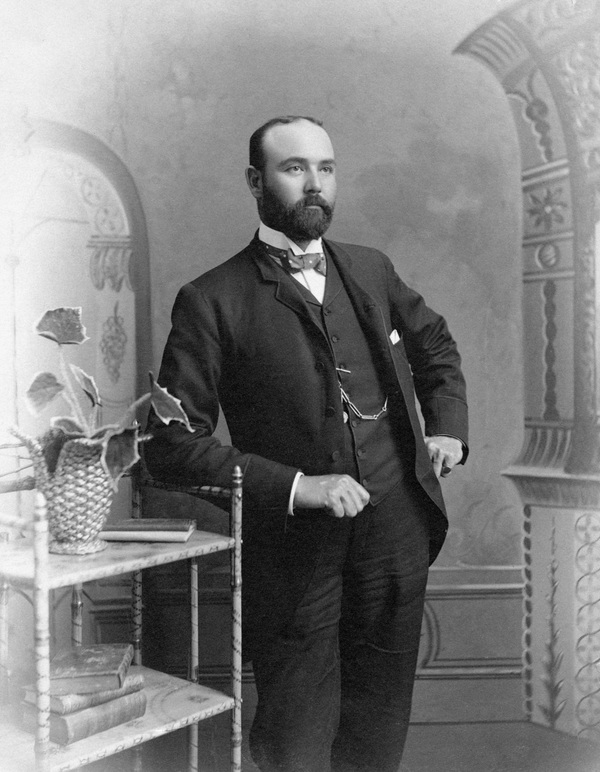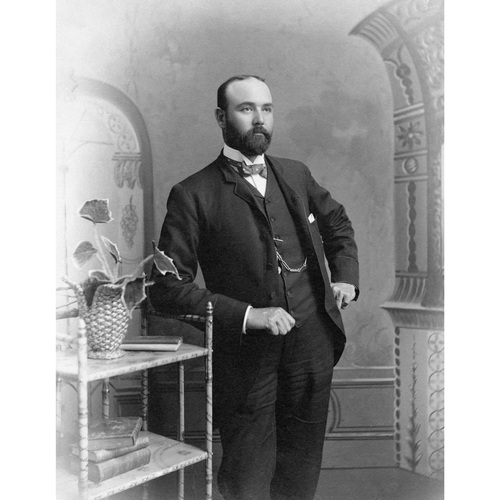
Source: Link
HULL, WILLIAM CHARLES JAMES ROPER, rancher, meat packer, businessman, and philanthropist; b. 20 Dec. 1856 at Childhay Farm, Broadwindsor, England, son of Arthur Hull and Honora James Berry; m. 29 Oct. 1903 Emmeline Mary Ellis, née Banister (d. 11 March 1953), in Davisburg (Alta); they had no children; d. 4 April 1925 in Calgary.
The son of a breeder of “high-class stock,” William Roper Hull attended school in Dorchester and Bridport in Dorset. In 1873, along with his brother John Roper Hull, he left England for the interior of British Columbia, where their uncle William James Roper raised cattle near Kamloops. After travelling by steamer to Victoria via Panama, they boated up the Fraser River and reached Kamloops on foot. With little more than their personal effects, the brothers began ranching near Edith and Hull lakes and by 1880 were grazing cattle and horses. Three years later, when they found themselves with a surplus of horses, they drove 1,200 of them over the Crowsnest Pass to Calgary and sold them to the North-West Mounted Police and the North-West Cattle Company [see Frederick Smith Stimson*]. In 1886 the Hull brothers and a partner, Walter Pound Trounce, set up a butchering and livestock-trading business known as Hull, Trounce and Company. William Hull and Trounce moved to Calgary to run its head office while John Hull remained in Kamloops. The partners were the first to integrate cattle raising, meat packing, and retailing on a large scale in Alberta. During their initial year they brought into the Alberta district the first consignment of cattle shipped by rail from the west; delivered at Calgary, it was sold to the McDermott and Ross Ranche. Over the course of 1886 Hull and Trounce ordered in a total of 500 horses and 3,000 cattle, selling two-thirds of them and utilizing the remainder to stock their first ranch, the 25, near Nanton.
Hull’s arrival in Calgary coincided with the golden age of the western Canadian ranching frontier. From the early 1880s the human and bovine populations grew dramatically. Hull was able to purchase cattle and other livestock from area ranchers and farmers and sell the meat in town and in distant markets. In May 1887 his company obtained the profitable contract for supplying beef to the Pacific division of the Canadian Pacific Railway. It established butcher shops the following year at Banff, Donald, Revelstoke, and Kamloops, and later in Anthracite, Canmore, Golden, and Field.
About 1890 Trounce left the partnership, and William and John formed Hull Brothers and Company. By 1891 they were the largest butchering establishment in Calgary. They had a slaughterhouse on the Bow River and, in Calgary, a stone packing plant with refrigerated chilling rooms, a cold-storage area, and the company’s Pioneer Meat Market, which sold a variety of fresh meat, poultry, and fish. From the beginning their main product was beef. To process it they designed a modern, partially mechanized system that involved cutting by hand and movement by steam hoist and conveyor. In the 1890s much of the meat was sold locally, though a considerable amount was shipped on CPR refrigerator cars to the brothers’ shops in other locations. The Hulls also supplied the railway’s dining cars and wholesale distributors throughout southern Alberta and British Columbia. W. R. Hull relied on small margins and high volume – he sometimes dropped his prices below cost to beat out competition.
Hull closely integrated his Pioneer market with his company’s second ranch, a 4,000-acre operation south of Calgary on Fish Creek, in the Bow River valley, where close to 1,000 steers were regularly grazed and fed. The Hulls had first leased this land from Senator Théodore Robitaille* in 1887 and bought it in 1892. The Bow Valley Ranche became known for its experiments to find the best production techniques. W. R. Hull undertook irrigated farming on a large scale. In 1893 he spent $2,000 to construct a ditch off the Bow to water 500 acres of bottom land along Fish Creek; he estimated that he recouped the cost from the extra yields of oats and hay in the first year. Some three years later he ran a second ditch to water an additional 800 acres. The ranch, often referred to as Hull’s Irrigation Farm, used modern raking and stacking machines to put up roughage. As one of the major agricultural showpieces in the North-West Territories, it played a role in helping the cattle industry move from crude, open-range ranching to intensive mixed farming. The ranch was also a visual showpiece. Hull seems initially to have used the 25 as his home, but after the log dwelling on the Bow ranch burned in 1895, he decided to replace it with a magnificent house as his main residence. Designed by James Llewellyn Wilson of Calgary, the two-storey mansion built the following year – it is now a restaurant in Fish Creek Provincial Park – was an excellent example of the Queen-Anne style in a rural setting. Its doorway was flanked by whale ribs, string quartets played on the lawn during extravagant garden parties, and upper-crust English gentlemen were frequent visitors.
The erection of Hull’s residence coincided with the dissolution of his partnership with his brother. William took the Alberta end of their business and John the Kamloops holdings. In 1902 W. R. Hull sold the Bow Valley Ranche and his beef businesses to cattle king Patrick Burns* so that he could concentrate on other interests. With Alfred Ernest Cross*, William Edward Cochrane, and others, he had founded the Calgary Brewing and Malting Company in 1892. He was involved too in W. Roper Hull Limited, a ranching, farming, and insurance agency. As a property broker and owner, he made a major impact. Among his holdings were the 6,000-acre Oxley Ranch near Claresholm that he bought in 1903 and the 37,500-acre Walrond Cattle Ranch in the foothills north of Pincher Creek [see Duncan McNab McEachran], which he leased for a period beginning in 1909. In Calgary he had a number of substantial buildings constructed. His five commercial blocks included the Hull Opera House (1893) and the Grain Exchange (1908–10), and he put up office blocks in Edmonton, Medicine Hat, and Lethbridge. There can be little doubt that he made a great deal of his money through real-estate ventures – he seems to have had a gift for recognizing locations that would jump in value. For example, in Calgary, he paid $7,500 for a corner lot at 8th Avenue and Centre Street in 1886, put up a small butcher shop, and sold the property for twice the original price seven years later.
Perhaps more than anyone else, Hull symbolized the business and ranching aristocracy for which the early prairie west has become famous. He consistently used his wealth to shape an Old World social and cultural environment in southern Alberta. The opera house is a case in point. With a seating capacity of 1,000, it hosted operatic and theatrical presentations by famous touring companies, school concerts, fund-raising productions, auction sales, and dances. In later years he continued the custom, started on his Bow Valley Ranche, of turning his home into a centre for refined social activities. After selling the Bow to Burns, he required living quarters for himself and his new wife, a daughter of Albert Edward Banister, a veterinarian who had emigrated from Bridport to Davisburg to farm. Hull’s second mansion, on the fringe of Calgary, was even grander than his first, on Fish Creek. Designed by Hodgson and Bates, the architects of the Grain Exchange, it was named Langmore after the Hull family home in England. It took two years to build and cost $12,000 and another $3,000 to furnish. Its style was European, but the setting was distinctly western. “When I first came here to live,” Mrs Hull later remembered, “the prairie stretched away before us. There were not any fences and often we would sit and watch from our windows, riders jumping hurdles and practicing for the races.” Eventually the grounds were landscaped and the garden parties held there were renowned. Such entertainments exuded the values and the lifestyles that Hull and many of his peers had brought to the west. In 1922 the Hulls returned to their former Bow residence, which was still owned by Patrick Burns, to help entertain Arthur Neville Chamberlain, a British mp and future prime minister, then on a tour of Canada.
W. R. Hull was a very capable businessman who also had a keen sense of social responsibility. At his death in 1925 he left instructions that a major portion of his $1.6 million estate should be set aside to build an orphanage. By the time of Mrs Hull’s death in 1953 the value had risen to $5 million. Expected to be constructed before 1956, the William Roper Hull Home was not officially opened until 1962. Now known as Hull Child and Family Services, this agency operates, with the Calgary Board of Education, the William Roper Hull School, to provide programs for students with behavioural and emotional difficulties. Other organizations that benefited from Hull’s estate include the Anglican diocese of Calgary, the Red Cross, and various hospitals.
GA, M 8688/7; NA-14-1. GRO, Reg. of births, Netherbury, 20 Dec. 1856. Univ. of Birmingham Library, Special Coll. (Birmingham, Eng.), Chamberlain papers, [Arthur Neville Chamberlain’s] travel journal, western Canadian trip, September–October, 1922. Calgary Daily Tribune, 11 Oct. 1893. Calgary Herald, 13 Feb. 1889; 3 March 1891; 13 Oct. 1923; 18 Nov. 1933; 21 Oct. 1996; 18 Jan. 1998; 5 Feb., 23 Sept. 2003. Calgary News Telegram, 11 Jan., 1 Nov. 1913. Globe, 17 Oct. 1891. Pincher Creek Echo (Pincher Creek, Alta), 23 Sept. 1997. Alberta Geneal. Soc., Edmonton branch, Alberta: index to registration of births, marriages and deaths . . . (1v. to date, Edmonton, 1995–?), 1 (1870 to 1905): 262. Mary Balf, Kamloops: a history of the district up to 1914 (Kamloops, B.C., 1969). Canadian who’s who, 1910. Commercial (Winnipeg), 5 (1886–87): 667. L. V. Kelly, The range men (75th anniversary ed., High River, Alta, 1988). H. C. Klassen, Eye on the future: business people in Calgary and the Bow valley, 1870–1900 (Calgary, 2002). A. O. MacRae, History of the province of Alberta (2v., [Calgary], 1912). Newspaper reference book. “Out of our past,” comp. Kelly Untinen, Sunday: Calgary Herald Magazine, 3 March 1991: 5.
Cite This Article
Warren M. Elofson, “HULL, WILLIAM CHARLES JAMES ROPER,” in Dictionary of Canadian Biography, vol. 15, University of Toronto/Université Laval, 2003–, accessed April 30, 2025, https://www.biographi.ca/en/bio/hull_william_charles_james_roper_15E.html.
The citation above shows the format for footnotes and endnotes according to the Chicago manual of style (16th edition). Information to be used in other citation formats:
| Permalink: | https://www.biographi.ca/en/bio/hull_william_charles_james_roper_15E.html |
| Author of Article: | Warren M. Elofson |
| Title of Article: | HULL, WILLIAM CHARLES JAMES ROPER |
| Publication Name: | Dictionary of Canadian Biography, vol. 15 |
| Publisher: | University of Toronto/Université Laval |
| Year of revision: | 2005 |
| Access Date: | April 30, 2025 |



